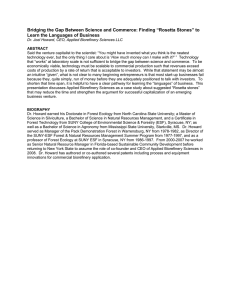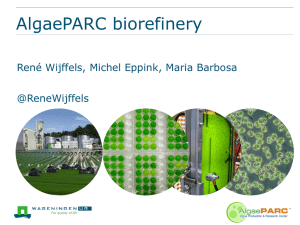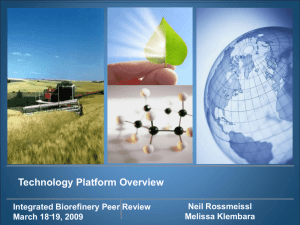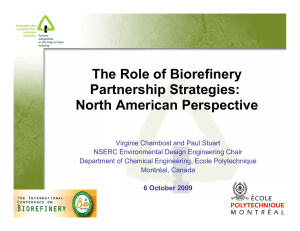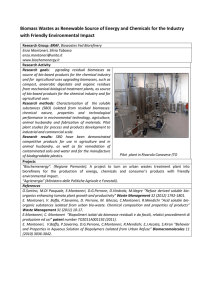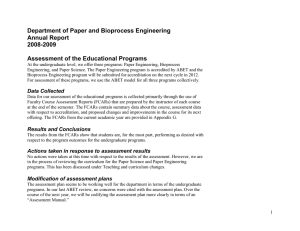Executive Leaders’ Panel: Transforming to the Forest Biorefinery
advertisement
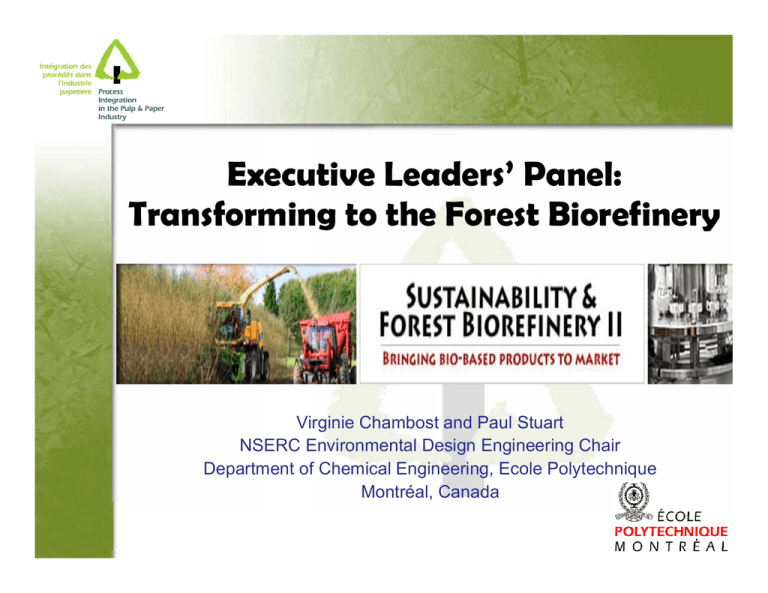
Executive Leaders’ Panel: Transforming to the Forest Biorefinery Virginie Chambost and Paul Stuart NSERC Environmental Design Engineering Chair Department of Chemical Engineering, Ecole Polytechnique Montréal, Canada Presentation Objective Forest industry strategists are talking about “revenue diversification” and industry transformation via the forest biorefinery…. …but do forestry company executives know how to go about designing and implementing the forest biorefinery? …and do forestry executives recognize that the biorefinery represents more than revenue diversification? …it is a change in the core business… it requires enterprise transformation to be successful… Presentation Outline • Case study: ethanol is an interesting biorefinery product to consider, but it involves risks • The basic issues: • Biorefinery implementation strategy • Biorefinery design strategy • The critical supply chain context for the ethanol case study • Preliminary concepts for designing the biorefinery supply chain: • Operational-level scheduling including… • Margins-centric operating policy • Operations-driven process model • Tactical level SC considerations • ...and this represents an important transformative change Presentation Outline • Case study: ethanol is an interesting biorefinery product to consider, but it involves risks • The basic issues: • Biorefinery implementation strategy • Biorefinery design strategy • The critical supply chain context for the ethanol case study • Preliminary concepts for designing the biorefinery supply chain: • Operational-level scheduling including… • Margins-centric operating policy • Operations-driven process model • Tactical level SC considerations Is Cellulosic Ethanol the Right Strategy? Peak at ≈3 $/gal Source: Gulf Ethanol Corp Ethanol price volatility due to: Volatile crude oil and natural gas prices Changes balance between supply and demand Diverse feedstock types and their relative competitiveness Energy legislation – tax credits and incentives In 4 months, ethanol prices dropped by half… How can companies stabilize margins in the context of volatility and uncertainty? 12 November <1.5 $/gal Source: Gulf Ethanol Corp Biochemical Ethanol Technology ≈4.2$/gal ≈2.2$/gal Source: NREL - 2006 ≈0.6$/gal Source: NREL - 2006 Should Biochemical Ethanol be Implemented Today? July 2007 Scenario @ 3 $/gal November 2007 Scenario @ 1.5 $/gal Source: NREL - 2006 Is Cellulosic Ethanol the Right Product? Implementing the forest biorefinery is about mitigating risk… …and clearly ethanol represents a great opportunity, but also presents risks These risks can be mitigated as part of an overall forest biorefinery product design strategy, e.g. What derivatives can be made from ethanol? What opportunities are there with by-product lignin? What manufacturing flexibility between products is required? How should the biorefinery products be delivered? Is Cellulosic Ethanol the Right Product? Implementing the forest biorefinery is about mitigating risk… …and clearly ethanol represents a great opportunity, but also presents risks These risks can be mitigated as part of an overall forest biorefinery product design strategy, e.g. What derivatives can be made from ethanol? What opportunities are there with by-product lignin? What manufacturing flexibility between products is required? How should the biorefinery products be delivered? How do we use SC analysis to evaluate product portfolio options & manufacturing flexibility, and the implied enterprise transformation? Presentation Outline • Case study: ethanol is an interesting biorefinery product to consider, but it involves risks • The basic issues: • Biorefinery implementation strategy • Biorefinery design strategy • The critical supply chain context for the ethanol case study • Preliminary concepts for designing the biorefinery supply chain: • Operational-level scheduling including… • Margins-centric operating policy • Operations-driven process model • Tactical level SC considerations Definition: Building Blocks and Derivatives… Co-products or wastes? Waste Chips Biomass Pulp and Paper Mill Yield? Building Block Yield? Yield? Derivative Deriva tive P&P Products $$ Main Biorefinery Products to Market $$$$ Reducing Volumes, Flexible Throughputs… Increasing Process Complexity Case Study Example: Ethanol to Ethylene to Polyethylene… Waste Chips Biomass Pulp and Paper Mill P&P Products Ethanol Ethylene PE Strategic Approach for Implementing the Biorefinery Phase I Lower Operating Costs: Replace fossil fuels at mill (natural gas, Bunker C), and/or Produce “building block” chemicals Lower risk technologies in Ma s ge n e all ch Compete internally for capital Phase II Increase Revenues: Manufacture of derivatives Market development for new products Higher process complexity and technology risk Partners essential Phase III Improve Margins: Knowledge-based manufacturing and production flexibility Business flow transformation Product development culture Off-shoring, Outsourcing, etc… Select the most sustainable product platform and partner(s) Company culture transformation SCM key to success Strategic Vision: Phase III must determine Phase I Strategic Approach for Implementing the Biorefinery Phase I Lower Operating Costs: Replace fossil fuels at mill (natural gas, Bunker C), and/or Produce “building block” chemicals Lower risk technologies Phase II Increase Revenues: Manufacture of derivatives Market development for new products Higher process complexity and technology risk Partners essential Phase III Improve Margins: Knowledge-based manufacturing and production flexibility Business flow transformation Product development culture Off-shoring, Outsourcing, etc… Let’s elaborate on this… Margins improvement is the goal Strategic Vision: Phase III must determine Phase I Designing the Transition to the Forest Biorefinery Promising Biorefinery Products Technology Strategy Product Design LCA Advanced Thermal Pinch Analysis Large Block Analysis of Processes Supply Chain Management Process Simulation Set of Preferred Biorefinery Configurations MCDM Reconciled Process and Economic Data Process Design Preliminary Engineering Design the Transition to the Forest Biorefinery Promising Biorefinery Products Technology Strategy Product Design LCA Advanced Thermal Pinch Analysis Large Block Analysis of Processes Supply Chain Management Process Simulation Set of Preferred Biorefinery Configurations MCDM Reconciled Process and Economic Data Process Design Preliminary Engineering The Biorefinery Supply Chain will be Significantly More Complex Existing SC Biorefinery SC “Unleashing” Supply Chain Value Forestry Company Chemicals Company Forest Biorefinery Supply Chain Supply Chain Supply Chain …but there is more value to be unleashed Manufacturing Flexibility Ethylene to Partner Engineered Polyethylene Ethanol to Blend Tank Do we need break-through technologies for the biorefinery? Perhaps… but it is the unique product portfolio and its delivery that are key Operating policies and corporate culture: Manufacturing-centric Margins-centric Once you have transformed to a margins centric operating policy, then you can exploit manufacturing flexibility Achieving this transformation is essential for biorefinery success …but what does this involve? Presentation Outline • Case study: ethanol is an interesting biorefinery product to consider, but it involves risks • The basic issues: • Biorefinery implementation strategy • Biorefinery design strategy • The critical supply chain context for the ethanol case study • Preliminary concepts for designing the biorefinery supply chain: • Operational-level scheduling including… • Margins-centric operating policy • Operations-driven process model • Tactical level SC considerations Supply Chain 101: The Three SC Levels ii TACTICAL iii iv Design the Supply Chain Network : facility location, transportation mode, etc. v OPERATIONAL SC DECISION LEVELS STRATEGIC i vi vii viii Coordinate & set the appropriate operating performance targets ix x xi xii Manage the activities that need to be performed to meet performance objectives PROCUREMENT PRODUCTION DISCTRIBUTION SUPPLY CHAIN CYCLES CUSTOMER TACTICAL OPERATIONAL SC DECISION LEVELS STRATEGIC The Key to Success is Defining the Unique Biorefinery SC i Key elements toii develop iiia uniqueiv SC capability 1. Represent biorefinery manufacturing processes at the SC level v vi vii viii 2. Coordinate the SC cycles – implement margins based SC policy 3. Exploit manufacturing flexibility to mitigate against price volatility ix x xi This represents a significant transformation for manufacturingcentric industries such as P&P… PROCUREMENT PRODUCTION DISCTRIBUTION SUPPLY CHAIN CYCLES CUSTOMER xii TACTICAL OPERATIONAL SC DECISION LEVELS STRATEGIC The Key to Success is Defining the Unique Biorefinery SC i iii Key elements toii develop a unique SC capability iv 1. Represent biorefinery manufacturing processes at the viSC level vii v viii 2. Coordinate the SC cycles – implement margins based SC policy 3. Exploit manufacturing flexibility to mitigate against price volatility ix x xi This represents a significant transformation for manufacturingcentric industries such as P&P… PROCUREMENT PRODUCTION DISCTRIBUTION SUPPLY CHAIN CYCLES CUSTOMER xii Using ABC-Like Accounting for the Biorefinery Traditional Cost System (Evolution of Taylorism) Advantages • Simple • Focuses on unfavorable • Poor feedback for decision making • Cost distortion due to inappropriate • Consistent and thus, • Misrepresentation of mill operations due variances for each period adequate for financial reporting Activity-Based Costing (Developed in mid-’80/‘90s) Key limitations Advantages • Elaborated for the needs of modern manufacturing environments • Models how resources are consumed by the “hidden factory” • Uses a set of resource & activity drivers based on observable measures treatment of overheads to the use of inappropriate standards Key limitations • Focuses on overheads • Simplified approach typically used for the analysis of direct costs in complex manufacturing environments • Cost modeling approach typically applied in discrete industries, not adapted for continuous-process production environments 25 Gunasekaran et al. (1999), Kaplan et al (1998, 1998), Thormählen (1998), Emblemsvag (2001), Steen & al. (1994), Miller (1985) Operations-Driven Cost Model Representing the Biorefinery Local Factors Overhead Cost Table Routings Overhead Calculation Allocation Script Allocation Base Information Table Cost information Overhead Work Center Resource Unit Cost Table Specifically Allocated Overhead Table Cost Object Legend Cost Flow: Input – « Bottom-up »: Input – Overhead: Arbitrary Allocation: Specific Allocation: Process Work Center - i Routings Process Cost Script ●●● Specific Calculation Process Work Center - 1 Local Factors Routings Local Factors Process Cost Script Routings Process Cost Script Specific Calculation Process Value Table Specific Calculation Tag Table Process information Process Work Center - n Local Factors Understanding the Direct Costs Run8 This information can be effectively incorporated into the margins-centric SC TACTICAL OPERATIONAL SC DECISION LEVELS STRATEGIC The Key to Success is Defining the Unique Biorefinery SC i iii Key elements toii develop a unique SC capability iv 1. Represent biorefinery manufacturing processes at the SC level v vi vii viii 2. Coordinate the SC cycles – implement margins based SC policy 3. Exploit manufacturing flexibility to mitigate against price volatility ix x xi This represents a significant transformation for manufacturingcentric industries such as P&P… PROCUREMENT PRODUCTION DISCTRIBUTION SUPPLY CHAIN CYCLES CUSTOMER xii Exploring the Biorefinery SC Design and Management • • • • For a given product portfolio: Fixed number of SC design configurations based on system analysis Explore the margins-based SC management strategy: this implies a significant transformation… Explore the impact of key factors on profit – especially price scenarios based on possible market conditions Design for manufacturing flexibility in the biorefinery… Problem Analysis Modified SC Design Configurations Tactical – Performance Target (month/years) Operational - Execution (days/weeks) Multi-scale SC planning Price scenarios Case Study: BCTMP Mill Distribution/Demand Cycle EXPORT MARKET SUPPLY REGION A Customers Internal Suppliers External Suppliers Manufacturing Cycle PRODUCTION LINE #2 – RECIPE r Swap Supply Chemical Pre-Treatment Chip Piles Specie e SUPPLY REGION A Drying/ Finishing Bleaching Pulp Storage grade g PRODUCTION LINE #1 – RECIPE r Chemical Pre-Treatment Internal Suppliers Pressurized Refining Pressurized Refining Drying/ Finishing Bleaching External Suppliers Chipping DOMESTIC MARKET Swap Supply Logs Storage Specie e Customers INTERNAL CUSTOMER Fibre Procurement Cycle Fibre Supply • Procurement & production cycles • Higher-level: 1 year fibre procurement plan based on forecasts • Lower-level: 2-3 months, select the best opportunities Æ right timing (according to production plan), right cost Focus: Profitable alignment of fibre supply, production capacity and pulp requirements Fibre Demand • Production & demand cycles • Higher-level: 2-3 months, campaign plan on each line • Lower-level: allocation of confirmed & current orders, respect promised time windows 30 Three Scenarios Examined Non-Integrated Planning Production campaigns are fixed according to industrial heuristics - 5 weeks maple, 1.5 weeks birch Fibre procurement needs to adapt accordingly Recipes are fixed according to mill’s standards Integrated Margins-Centric Planning Procurement and production planning are optimized simultaneously Recipes are fixed according to mill’s standards Integrated Planning Accounting for Recipe Flexibility Procurement and production planning are optimized simultaneously The best recipe can be chosen from a set of possible scenarios Exploiting Process Flexibility Biorefinery SC strategy should exploit manufacturing flexibility Profit Improvement 20% 15% 10% 5% Supply chain Not Integrated (NI) optimization considering manufacturing flexibility Integrated (I) Integrated with ratios (I+) Supply chain optimization considering tactical planning at the operations level 0% -5% Base case profit Case I Aligned Supply Opportunities Case II Constrained Fibre Procurement Case III New Supply Opportunities TACTICAL OPERATIONAL SC DECISION LEVELS STRATEGIC The Key to Success is Defining the Unique Biorefinery SC i iii Key elements toii develop a unique SC capability 1. Represent biorefinery manufacturing processes at the SC level v vi vii 2. Coordinate the SC cycles – implement margins based SC policy 3. Exploit manufacturing flexibility to mitigate against price volatility ix x xi This represents a significant transformation for manufacturingcentric industries such as P&P… PROCUREMENT PRODUCTION DISCTRIBUTION SUPPLY CHAIN CYCLES CUSTOMER iv viii xii UPM-Kymmene Report to Investors: Have they gone far enough? Take-Away Messages Risk mitigation associated with the implementation of the biorefinery can be achieved by employing systematic product and process design methodologies The characteristics of the product portfolio are the key to robust business models Transforming to a margins-centric supply chain is critical for manifesting biorefinery value This should be coupled with design for manufacturing flexibility, and development of knowledge-based systems These transformational issues are key to having a unique biorefinery-enhanced SC that will result in a sustainable biorefinery Executive Leaders’ Panel Transforming to the Forest Biorefinery Thank you!
